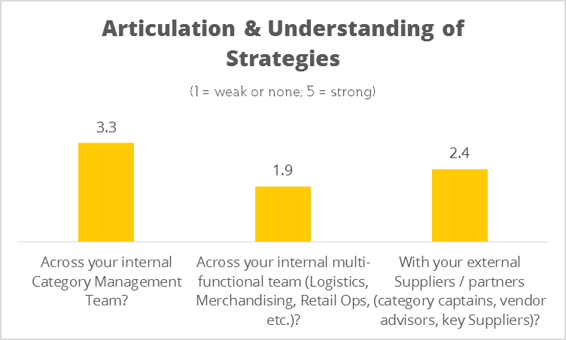Last week’s blog (Category Management in Retail is changing — how are you keeping up?) explained why Retailers need to have well-defined and articulated strategies and outlined what a solid strategy should include.
Remember that strategies defining category management in retail create the foundation for achieving your goals and objectives as an organization. That’s why we included a questionnaire as part of last week’s post — so individuals can start to understand where opportunities exist.
This week, we dive into the results first … Then, we explain the next part of the evaluation — Part 2: Own Your Category Management Approach.
Last week’s survey asked for self-reporting ratings across different areas that should be included in a Retailer’s strategies. The scale was (1 = weak to no understanding; 5 = strong understanding).
Topline Results
- Overall Goals & Objectives. These were the highest rated areas overall in the survey with "Vision & Mission Statements" at 3.7. Although these areas received the highest rating, according to the scale (LOW 1 -- 5 HIGH), they scored only as "medium" to "medium-strong", indicating moderate understanding.

- Shopper-Focused Strategies. When asked about target Shoppers (including the additional services available in-store to meet Shopper needs), Target Shopper definition and focus is a clear opportunity for most Retailers with a “below Medium” 2.7 score. These results are consistent with discussions that I’ve had with many Retailer clients. The rating here reinforces the very limited focus or understanding of the target Shopper, but indicates a huge area of opportunity. The irony here is that there's so much emphasis on Shopper Marketing in Retailers, but they don’t necessarily have well-defined target Shoppers.

- Tactical Strategies. Participants scored an average of 3.7/3.6 on their pricing and promotion strategies, but much lower on their assortment and shelving strategies. Retailers can take advantage of the opportunitity to better define their assortment and shelving strategies and processes to reach Shoppers in-store.
Communication is key — here’s why

- Articulation & Understanding of Strategies. Articulating the well-defined strategies both internally and externally is also key to achieving goals. When we asked survey participants how well did their organization articulate overall strategies, the results were varied, but rated “moderate” to “low”.
Scores are “weak” across internal multi-functional teams and “low-medium” with external Manufacturers/Vendors/Suppliers, indicating an opportunity for Retailers to improve their:
- INTERNAL strategic approach and understanding to increase alignment across multi-functional teams; and
- EXTERNAL strategic approach and understanding with Manufacturer / Vendor / Supplier partners. Better articulated strategies will increase alignment, improve decision making to align to target Shopper, improve recommendations developed by external partners, and increase collaboration.
Participant Comments
The survey also asked for written feedback on the biggest areas of opportunity for their Retail organization as related to overall strategy. In net, some big opportunities for Retailers to both improve their strategies and articulate them internally and externally. Below represents a selection of the comments received:
| “For individual departments to buy in to the idea that they serve a specific purpose as a piece of the whole; they shouldn’t all be chasing the same benchmarks.” |
| “We have some well-developed parts of our Retail strategy, but are also missing some important elements that I didn't realize. We need to fill in those gaps and continually evolve our strategy as our Shopper and the market change.” |
| “(Suppliers) need to know the overall ‘plan’ and how the various parts fit together so they can support that plan, but we can’t share it with them since we’re not in alignment ourselves.” |
PART 2: OWN YOUR CATEGORY MANAGEMENT APPROACH
Regardless of how large or small your retail organization is (a few stores or a large chain), you should follow a category management process that is specific to you. The category management process below is an easy-to-use and easy-to-understand example that captures the key steps.
As a Retailer, YOU own and define your own unique process, driven by your internal Retail strategies. It’s not the Manufacturer/Vendor/Supplier who owns the process - it’s you - the Retailer!

Some of the most important parts of category management process should include consideration for:
- What level (or tier) of category management do you compete in? How does this compare to your competitors?
- How well do you define and manage your categories and subcategories?
- Do you assign category roles and strategies and allocate resources accordingly?
- Do your category role assignments tie in with tactical objectives?
Now that you understand the category management process, it’s time for you to evaluate how well your organization is doing. Head over to Part 2 of our Category Management Scorecard now and check back next week for the results.




